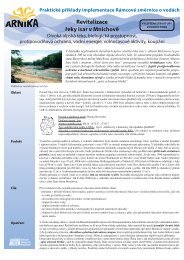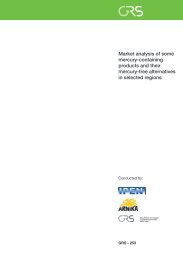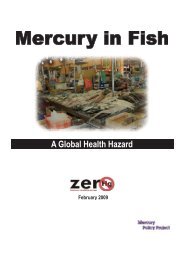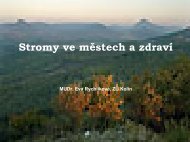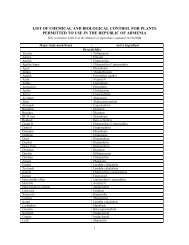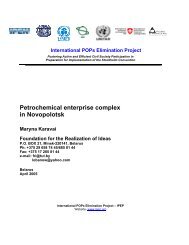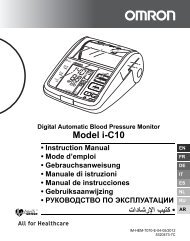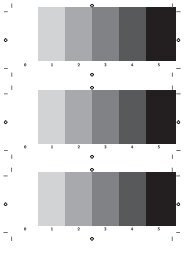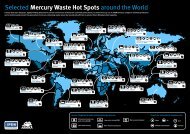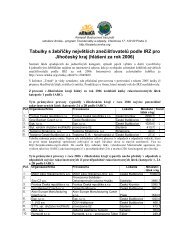Waste Incineration Residues - Arnika
Waste Incineration Residues - Arnika
Waste Incineration Residues - Arnika
Create successful ePaper yourself
Turn your PDF publications into a flip-book with our unique Google optimized e-Paper software.
Environmental pollution by dispersion of solid residues<br />
from waste incineration; the legacy of ignorance<br />
Case study of persistent hazardous pollutants in fly ash and bottom ash in the<br />
Netherlands<br />
Arne Schoevers<br />
February 2004
This report has been prepared by <strong>Waste</strong> & Environment on request of the<br />
IPEN Dioxins, PCBs and <strong>Waste</strong>s Working Group.<br />
Author: Arne Schoevers<br />
<strong>Waste</strong> & Environment<br />
Dr. van der Knaaplaan 5<br />
2283 CW Netherlands<br />
Phone/fax +31 70 3947367<br />
E-mail: wastenet@uwnet.nl<br />
CONTENTS<br />
SUMMARY<br />
1 INTRODUCTION<br />
2 ASH AND FILTER RESIDUES<br />
3 COMPOSITION OF FLY ASH AND BOTTOM ASH<br />
4 LEACHATE<br />
5 THE TOXIC WASTE TRAP<br />
6 ASH PRODUCTION AND DISPOSAL<br />
6.1 Government policy; deception and concealment<br />
6.2 Fly ash and boiler ash<br />
6.3 Environmental impact of fly ash dumping<br />
6.3.1 The asphalt disposal route<br />
6.3.2 The landfill disposal route<br />
6.3.3 The salt and coal mine disposal routes<br />
6.3.4 Quantity of dioxins in fly ash<br />
6.4 Bottom ash<br />
6.5 Environmental impact of bottom ash dumping<br />
6.5.1 The road bedding disposal route<br />
6.5.2 The landfill disposal route<br />
6.5.3 Quantity of dioxins in bottom ash<br />
7 CONCLUSION<br />
LITERATURE REFERENCES<br />
2
SUMMARY<br />
From the mid 1980s, the Dutch government strongly promoted waste incineration as a "state of the art"<br />
alternative to landfilling. However, high levels of dioxin found in milk and cheese from cattle grazing<br />
near municipal waste incinerators in 1989, radically changed public opinion about incineration.<br />
Despite serious concerns of citizens against waste incineration, the Dutch government continued their<br />
policy to increase incineration capacity. Strong citizens protests forced government to drop a few new<br />
incinerator proposals, and to close down a few existing incinerators, but others have been build.<br />
Despite the fact, that the government was not able to increase the incineration capacity as initially<br />
planned, waste incineration has become a major route for waste disposal in the Netherlands.<br />
Toxic heavy metals contained in waste, are not destroyed, but are emitted via stack gases or discharged<br />
to surface water or remain in the bottom ash, fly ash and filter residues. Other toxic substances, such as<br />
dioxins and furans, are produced as a result of the combustion process.<br />
After incineration, approximately 28% of combusted solid waste remain as solid residues, from which<br />
bottom ash and filter ash are the largest fractions. These residues are contaminated with numerous<br />
hazardous substances. Some of the organic substances found in residues of incineration, i.e. dioxins and<br />
furans are classified as persistent organic<br />
pollutants (POPs), a class of toxic chemical pollutants that are harmful<br />
to human health and wildlife.<br />
Much efforts have been undertaken by the Dutch government to find disposal routes for incinerator<br />
residues, other than common landfilling. In addition, a deceptive vocabulary has been introduced to<br />
conceal the real nature of the alternative disposal routes. Consequently, dumping of toxic fly ash and<br />
bottom ash in the Dutch environment is promoted under the cloak of "recycling", and "useful<br />
application".<br />
The incinerator companies are consequently looking for the cheapest disposal routes. Roughly 45% of<br />
fly ash is used as a filler material in asphalt, and 55% is landfilled or exported to Germany and dumped<br />
in old salt and coal mines, since legislative restrictions for incinerator operators to export fly ash do not<br />
exist, or fail to be effective. The lack of effective measures to prevent persistent toxic substances in fly<br />
ash entering the environment is considered a major problem.<br />
Roughly 65% of bottom ash is used for road beddings, and hardening surfaces of industrial sites. This<br />
is much lower compared to previous years, because of growing concern about the negative<br />
environmental impact of dumping bottom ash under roads. Road constructors have been increasingly<br />
reluctant to further use bottom ash for road construction. Consequently, waste incinerators are saddled<br />
with large stockpiles of bottom ash.<br />
In the Netherlands, fly ash is a major route for dioxin contamination of the environment. In 1991, the<br />
quantity of dioxins in fly ash has been estimated 1020 grams (in TEQ) per year, which amount has<br />
been increased to 2671 grams (in TEQ) in 2000 after a few new incinerators have been build.<br />
Data provided by the operators of the Dutch waste incinerators in 1997 reveal an annual dioxin quantity<br />
of 190 - 195 grams (in TEQ). If these data are correct, this could indicate that the electrostatic<br />
precipitators (ESP-filters) are operating far below set standards and/or suffer upsets which strongly<br />
reduce dioxin capture rate of ESP-filters. And, air emissions can be expected to be much higher than<br />
the official estimates (which are based on the assumption that Dutch waste incinerators would<br />
operate to set standards).<br />
Although the Dutch government, and operators of waste incinerators consequently denied technical<br />
failures appearing on a larger scale, a survey by <strong>Waste</strong> & Environment in 1995 revealed that technical<br />
failure frequently occurs, often resulting in deliberate by-passes of the air pollution control equipment,<br />
during which the fouled flue gases leave the flue stack without adequate filtering.<br />
Although all Dutch waste incinerators are equiped with sophisticated air pollution control equipment,<br />
the background levels of dioxin in the Netherlands are very high. In 1996, the Health Council of the<br />
Netherlands announced that given current concentration of dioxin-like substances in the Dutch<br />
3
environment, the recommended (health protecting) levels for humans and in some cases for ecosystems<br />
are being exceeded. The Health Council deems this to be a matter of concern and believes that it<br />
constitutes an argument for further reducing existing concentrations.<br />
1 INTRODUCTION<br />
In many countries, waste is disposed of simply by dumping or landfilling, and until the 1970s this was<br />
the common practice of waste disposal in the Netherlands as well. Until the early 1970s only a few<br />
municipal solid waste incinerators (MSW-incinerators) have been built. With the closing of ocean<br />
disposal, exhaustion of landfill capacity, and growing concern of landfill sites that appeared to have<br />
been heavily contaminated with toxic pollutants, the Dutch government introduced a policy to move<br />
away from landfilling, and promoted waste incineration as a "state of the art" solution to the growing<br />
waste disposal problems. The proposals for building seven new municipal waste incinerators in the<br />
period 1971 - 1976, and one hazardous waste incinerator, received little public attention and concern.<br />
However, citizens concerns mushroomed in 1989, after the Lickebaert dioxin scandal received much<br />
publicity.<br />
The Lickebaert polder is an agricultural area north-east of Rotterdam-harbour. In 1989, tests showed<br />
high levels of dioxin in milk and cheese samples. As a result of the enormous media coverage and<br />
publicity, the government promptly ordered cow's milk and meat from the affected Lickebaert area to<br />
be collected systematically and destroyed.[1] A health protection measure that lasted until the end of<br />
1994. During these five years the production and sales of dairy products in the Lickebaert area was<br />
prohibited. And, the government started a nationwide research program to get detailed information<br />
about dioxin contamination of cow's milk in other regions. For this purpose cow's milk was examined<br />
in the vicinity of all Dutch waste incinerators and cable burn facilities.[2][3]<br />
The nationwide research program showed that dioxin output of all waste incinerators have been too<br />
high as well as dioxin levels of cow's milk. Further, the research program suggested that the high<br />
dioxin output from waste incinerators could be held responsible for toxic dioxin contamination of cow's<br />
milk and meat. In February 1990, Dutch government ordered that cow's milk and meat from a second<br />
contaminated area (near the waste incinerator of the city of Zaanstad, north of Amsterdam) should be<br />
collected systematically for destruction. Further, the production and sales of dairy products in that<br />
'Zaanstad-area' was prohibited.[2][3]<br />
As a result of the nationwide research program four municipal waste incinerators were ordered to close<br />
down immediatedly. And, in 1993 and 1994 two other municipal waste incinerators had to shut down.<br />
Surprisingly, the AVR-Rotterdam incinerator that was held responsible for the contamination of dairy<br />
products in the Lickebaert area received permission to continue its operation!<br />
Despite the serious concerns of citizens against waste incineration, the Dutch government continued<br />
their policy to triple the incineration capacity in 2000. [4][5] However, strong citizens’ protests forced<br />
government to drop a few new incinerator proposals, and to close down another existing incinerator.<br />
Although citizens protest have been successful in preventing the building of a few new incinerators,<br />
others have been build. And, despite the fact, that the government was not successful in increasing the<br />
incineration capacity as initially planned, waste incineration has become a major route for waste<br />
disposal in the Netherlands.<br />
Hazardous waste, but municipal and industrial waste as well, contains a great variety of toxic<br />
substances. Much of these toxic substances cannot be destroyed by incineration. Combustion merely<br />
changes the chemical composition and the toxicity of the substances burned. Combustion transforms<br />
solid and liquid waste into toxic residues, airborne emissions and contaminated waste water effluents,<br />
all of which seriously endanger public health and the environment. Toxic heavy metals contained in<br />
waste, are not destroyed, but are emitted via stack gases or discharged to surface water or remain in the<br />
bottom ash, fly ash and filter residues. In every case they constitute to health threatening discharges of<br />
toxic substances in the environment.<br />
Other toxic substances, originally not present within the waste stream, are produced as a result of the<br />
combustion process. Incinerators act as chemical synthesizers. At temperatures ranging from 400 tot<br />
1600oC, complex organic molecules break down into basic atoms. But, as the combustion gas cools on<br />
4
its way up the chimney and out of the stack, some atoms recombine to form new and often more<br />
hazardous compounds. These chemical re-combinations or 'products of incomplete combustion' (PICs)<br />
can be even more toxic than the original combusted waste. Dioxins and furans are beyond any doubt<br />
the most hazardous of these kind of substances. Dioxins is the collective name for numerous toxic<br />
chlorinated compounds that are undesirable by-products of combustion processes and chlorine<br />
industry. <strong>Waste</strong> incineration constitutes the greatest point source of emissions of dioxins and furans. In<br />
1994, the National Institute of Public Health and Environmental Protection (a Dutch governmental<br />
research institute) estimated that waste incinerators can be held responsible for over 80% of all dioxin<br />
emissions into the air in the Netherlands.[3]<br />
Despite the serious environmental pollution and the negative impact of air emissions to public health,<br />
the dispersion in the environment of solid residues, notably fly ash and bottom ash, may have an even<br />
more serious negative impact on the environment and public health. Yet, the risks of dispersion and<br />
exposure to fly ash and bottom ash are greatly underestimated, and receive little attention from<br />
governments, citizens, and environmental organisations.<br />
This report is addressing the persistent hazardous pollutants in fly ash and bottom ash from waste<br />
incinerators in the Netherlands. The data provided in this case study have been taken from (Dutch)<br />
governmental reports, scientific studies and expert findings to identify the types of risks of dispersion<br />
in the environment and human exposure to toxic substances from solid residues from incineration.<br />
2 ASH AND FILTER RESIDUES<br />
Combustion is a thermal process during which organic waste materials change their chemical<br />
composition and break down into basic atoms after being exposed to high temperatures in the presence<br />
of oxygene. The flue gases, as well as dust particles which are not captured by filters are emitted into<br />
the air by the stack (chimney). And, large quantities of waste water from wet flue gas filter devices are<br />
discharged in the environment.<br />
Inert materials in the solid waste stream, such as stony materials, and most metals, which are<br />
incinerated together with the organic waste fraction are not combustible, and will fall through the grate<br />
slits of the furnace, and end up in the bottom ash at the end of the incineration process. Approximately<br />
25% of the quantity of municipal solid waste (MSW) fed to the grate furnaces ends up as bottom ash<br />
after the combustion process. Bottom ash is also known as 'slag'.<br />
Fly ash are small dust particles in flue gases, and are captured by electrostatic precipitators (ESPfilters)<br />
after the flue gases leave the boiler. Fly ash are also known as 'ESP-ash'. Approximately 1,6%<br />
of the quantity of municipal solid waste feeded to the grate furnaces ends up as fly ash after the<br />
combustion process.<br />
A third residue of waste incineration is boiler ash. Small ash particles attach to the boiler, and are<br />
removed by mechanical knocking devices, or are manually removed during periods of maintenance<br />
work. Less than 0,1% of the quantity of municipal solid waste feeded to the grate furnaces is collected<br />
as boiler ash.<br />
If an incinerator is equipped with (wet) flue gas filter devices (scrubbers), various (solid) residues are<br />
produced, i.e. scrubber salts, filter cake, sludges, and gypsum. Less than 1% of the quantity of<br />
municipal solid waste fed to the grate furnaces remain as filter residues.<br />
Summarising, after incineration approximately 28% of combusted solid waste will remain as solid<br />
residues.<br />
Combustion of liquid (toxic) waste results in much lower quantities of solid residues, because of the<br />
lower amount of solid substances in the liquid waste. However, incineration of liquid (toxic) waste, like<br />
chemicals, solvents and obsolete stockpiles of pesticides will produce flue gases with high levels of<br />
toxic substances, either in the form of toxic heavy metals and/or products of incomplete combustion,<br />
like dioxins and furans.<br />
5
3 COMPOSITION OF FLY ASH AND BOTTOM ASH<br />
Bottom ash, fly ash, boiler ash, and filter residues are contaminated with numerous hazardous<br />
substances. Public health is threatened seriously if human exposure takes place during a longer period<br />
of time. In particularly, fly ash, boiler ash, and filter cake contain high levels of toxic substances, such<br />
as heavy metals and dioxins/furans.<br />
Some of the organic substances found in residues of incineration, i.e. dioxins and furans are classified<br />
as persistent organic pollutants (POPs), a class of toxic chemical pollutants that are harmful to human<br />
health and wildlife. In the Netherlands, incinerator companies are not obliged to collect data on PCBs,<br />
HCBs or PAHs. As a result, they do not analyze residues for these persistent organic pollutants.<br />
Table 1. Average composition of fly ash from Dutch waste incinerators in 1997 (in milligrams per<br />
kilogramme). [6][7]<br />
Substance Average composition Number of<br />
(mg/kg) samples analysed<br />
aluminium (Al) 30294 17<br />
antimony (Sb) 682 17<br />
arsenic (As) 97 17<br />
barium (Ba) 1000 17<br />
bromium (Br) 997 17<br />
cadmium (Cd) 379 17<br />
calcium (Ca) 143529 17<br />
chloride (Cl) 74471 17<br />
chromium (Cr) 231 31 (from 1986-1995)<br />
cobalt (Co) 19 26 (from 1986-1995)<br />
fluor (F) 57 17<br />
potassium (K) 41376 17<br />
copper (Cu) 1154 17<br />
mercury (Hg) 2 17<br />
lead (Pb) 7671 17<br />
magnesium (Mg) 9765 17<br />
molybdeen (Mo) 50 17<br />
sodium (Na) 36282 17<br />
nickel (Ni) 88 30 (from 1986-1995)<br />
selenium (Se) 9 17<br />
silicon (Si) 30444 26 (from 1986-1995)<br />
strontium (Sr) 245 17<br />
sulphate (SO4) 32041 17<br />
tin (Sn) 1007 17<br />
vanadium (V) 30 27 (from 1986-1995)<br />
wolfram (W) 77 17<br />
zinc (Zn) 22488 17<br />
dioxins and furans<br />
(PCDD/F) as TEQ 0,0024 17<br />
6
Table 2. Composition of bottom ash from waste incineration in the Netherlands in milligrams per<br />
kilogramme. [8][9]<br />
Substance composition (mg/kg)<br />
aluminium (Al) not defined*<br />
antimony (Sb) 28 - 58<br />
arsenic (As) 19 - 23<br />
barium (Ba) 1275 - 1760<br />
bromium (Br) not defined*<br />
cadmium (Cd) 2 - 8<br />
calcium (Ca) not defined*<br />
chloride (Cl) 1050 - 2445<br />
chromium (Cr) 235 - 296<br />
cobalt (Co) not defined*<br />
fluor (F) not defined*<br />
potassium (K) not defined*<br />
copper (Cu) 669 - 3212<br />
mercury (Hg) 0,03 - 0,2<br />
lead (Pb) 1086 - 1637<br />
magnesium (Mg) not defined*<br />
molybdeen (Mo) 5 - 11<br />
sodium (Na) not defined*<br />
nickel (Ni) 40 - 86<br />
selenium (Se) 0,4 - 0,5<br />
silicon (Si) not defined*<br />
strontium (Sr) not defined*<br />
sulphate (SO4) 5059 - 12642<br />
tin (Sn) 62 - 77<br />
vanadium (V) 40 - 52<br />
wolfram (W) not defined*<br />
zinc (Zn) 1239 - 2125<br />
dioxins and furans<br />
(PCDD/F) as TEQ below detection limit<br />
* Not defined = no measurement carried out<br />
4 LEACHATE<br />
Toxic substances in fly ash and bottom ash are entering the environment after residues of incineration<br />
get in contact with rain water, ground water and in general after exposure to open air conditions. The<br />
leachate process can take up many years, although some substances react fast after exposure to water or<br />
common atmospheric conditions (like storage in open air). The speed of the leachate process is<br />
7
depending on the type of toxic substance, and the extend of exposure to water and atmospheric<br />
conditions.<br />
Table 3 gives figures of leachate for a number of heavy metals in fly ash and bottom ash respectively.<br />
Since the figures presented in table 2 are not collected under real outdoor conditons, but derived from<br />
tests in laboratories where outdoor conditions are imitated and accellerated, the results should be<br />
considered indicative. The actual leachate of (toxic) substances may be quite different under real<br />
outdoor conditions.<br />
Table 3. Average leachate for fly ash and bottom ash in mg/kg. [8][9][10]<br />
Substance Fly ash Bottom ash<br />
arsenic (As)
appear to be a vital element to dioxins and furans formation. This is one of the reasons why incinerators<br />
contribute to an enormous increase of toxic residues, and why incinerators are considered a major<br />
producer of toxic waste.<br />
In chapter two the solid residues of MSW incineration have been quantified to 28% of combusted<br />
waste. In other words, from every 1000 kg of solid waste combusted in an incinerator approximately<br />
280 kilogrammes remain as toxic waste. <strong>Incineration</strong> reduces the quantity of the waste that need to<br />
be disposed of, but the air emissions, waste water discharges and solid residues are a much larger<br />
environmental threat than any other type of waste treatment. <strong>Incineration</strong> gives the illusion of making<br />
waste disappear when, in fact, it reappears in different and often more hazardous forms. Indeed, a toxic<br />
waste trap.<br />
6 ASH PRODUCTION AND DISPOSAL<br />
6.1 Government policy; deception and concealment<br />
From the mid 1980s, the Dutch government is strongly promoting incineration of waste. However, the<br />
government is well aware that the parliament, although still in majority in favor of incineration, may<br />
change their point of view if large quantities of incinerator residues would end up on common landfill<br />
sites. Much effort has been undertaken to find alternative disposal routes. In addition, a deceptive<br />
vocabulary has been introduced to conceal the real nature of the alternative disposal routes.<br />
Consequently, dumping of toxic fly ash and bottom ash in the Dutch environment is promoted under<br />
the cloak of "recycling", and "useful application".<br />
In 1995, the Dutch government issued a directive with environmental specifications for construction<br />
materials, which include all materials that are used for building houses, offices, factories and roads. [9]<br />
Although fly ash and bottom ash should come to meet the limits (like all other construction materials<br />
and residues), the government decided that fly ash and bottom ash are exempt from this obligation! As<br />
a result, fly ash and bottom ash can used almost without any restriction.<br />
The incinerator companies are consequently looking for the cheapest disposal routes. Since alternative<br />
disposal routes often appear cheaper than landfilling, large quantities are just dumped under roads or<br />
exported. Legislative restrictions for incinerator operators to export fly ash do not exist, or fail to be<br />
effective, while requests to export (non-toxic) municipal solid waste is consequently rejected. This<br />
contradictive policy illustrates the attitude of the government to come to meet the interests of the<br />
incinerator companies as much as possible.<br />
In the next paragraphs the production and disposal of fly ash and bottom ash are described more in<br />
detail.<br />
6.2 Fly ash and boiler ash<br />
In the Netherlands, the annual production of fly ash is ranging from 79000 - 81000 tons. The fly ash<br />
production is quite steady because the quantity of incinerated waste has not been changed for the past<br />
few years. The annual production of boiler ash has decreased from 8800 tons in 1999 to 3800 tons in<br />
2002. [11]<br />
Approximately 35000 - 40000 tons of annual fly ash production is used as filler material for asphalt<br />
production. However, since fly ash is produced during the year, but asphalt is manufactured mainly<br />
during summer, and other filler materials compete with fly ash, not all fly ash can be disposed of as<br />
filler material in asphalt. [7][11][12]<br />
Approximately 44000 - 46000 tons of annual fly ash production is landfilled in the Netherlands, or<br />
exported to Germany and dumped in old salt and coal mines. [7][11] In 2002, 29500 tons are exported,<br />
in 2003, 45000 tons. [14] Most of the boiler ash is exported to Germany as well. [11]<br />
For the landfill disposal route, the fly ash is packed in so called 'big bags' (large plastic bags) and piled<br />
up in separate sections of common landfill sites. To stabilize the big bags, sand is squirted, or washed<br />
9
etween the bags to fill the hollow spaces. Alternatively, a fly ash mixture is used as top cover for<br />
common landfill sites.<br />
For dumping in old salt mines, two different methods are commonly used.<br />
1. Fly ash is packed in big bags and brought down in old salt mines to fill up mine galleries. The big<br />
bags with dry fly ash are piled up until the gallery is completely filled.<br />
2. At the entrance of a mine gallery, first a dam is build. Water from the mine is pumped up to the<br />
surface and mixed with fly ash. The mixture is pumped into the mine gallery. The dam prevents the<br />
liquid mixture entering other galleries. After a while, the fly ash has sedimented, and the water is<br />
pumped up again for making a new batch of mixture.<br />
For dumping in coal mines, the fly ash is mixed with cement, lime, sand and water. The amount of fly<br />
ash in this mixture depends on the composition of the fly ash and the technical specifications of the<br />
mortar that is needed, and is in the range of 15 - 75%. This mixture is used to build dams in coal mine<br />
galleries to prevent these galleries to cave in.<br />
Other use is a mixture of incinerator fly ash (24%), fly ash from electric power plants (46%), and<br />
cement (30%) to build a dam at the beginning of a gallery, to enable filling the gallery with waste<br />
sludges. [7]<br />
6.3 Environmental impact of fly ash dumping<br />
6.3.1 The asphalt disposal route<br />
Fly ash used in asphalt incorporates a few serious environmental and health risks. Instead of preventing<br />
this hazardous residue to get into contact with other materials and entering the environment, it is mixed<br />
with other filler material and bitumen, and the asphalt is used for road building. But, after less than 20<br />
years roads need new asphalt, and the old asphalt that need to be removed contains high levels of toxic<br />
substances. Result: the problem has been manyfolded!<br />
Second, during the removal of the old asphalt, fly ash will set free as a result of grinding, breaking and<br />
transport of the asphalt debris, polluting the environment and endangering the health of the road<br />
workers. And, during the life time of asphalt, small amounts of toxic substances will be dispersed into<br />
the environment, as a result of leachate.<br />
6.3.2 The landfill disposal route<br />
During handling of the big bags with fly ash, bags often get damaged, and ash is flowing out. After the<br />
big bags are piled up in the separate sections of the landfill site, the water that is used to squirt, or wash<br />
the sand between the bags get into contact with the fly ash, accelerating the leachate process. Moreover,<br />
heavy pressure exerted on the landfill can make big bags burst, increasing the leachate process any<br />
further.<br />
Similar with big bags, the fly ash mixture that is used as top cover for common landfill sites can rupture<br />
after heavy pressure exerted on the lower layers of the landfill will increase tension in the top cover. As<br />
a result, rain water easily get in contact with the waste landfilled below the cover layer, reinforcing the<br />
process any further. Inevitable, the rain water get in contact with heavy metals and other toxic<br />
substances and pollute the surface water after discharged to nearby canals at landfill<br />
sites that have drainage systems in operation. And, polluted water not discharged, finally reaches the<br />
ground water below landfill sites, where ground water flow is dispersing the pollution to a much bigger<br />
area.<br />
10
6.3.3 The salt and coal mine disposal routes<br />
Although the fly ash is dumped in the deep underground, geological processes are likely to enable toxic<br />
substances to enter the environment again. Common practice is to only partly fill up old mine galleries.<br />
Pressure and tension from the upper layers will make the galleries converge. A full convergency of the<br />
galleries may take a few hundred years for instable salt mines up to many thousand years for stable salt<br />
mines. During this period of convergency, ruptures enable water from upper or lower layers of ground<br />
water to flooding the galleries and getting in contact with toxic waste. The continuing convergency<br />
increases the pressure on the polluted water, pressing it upwards. Finally the polluted water will reach<br />
the upper layers of ground water, where ground water flow is dispersing the pollution to a much bigger<br />
area, and back into the living environment. [14][15][16][17]<br />
Despite the scientific evidence of these geological processes, advocates of hazardous waste dumping in<br />
salt mines claim salt mines used for this disposal route are dry, and flooding of mine galleries are not<br />
expected because of stable salt formations. However, during the past 140 years over half of all German<br />
salt mines have been flooded already. Once a mine has been flooded it is not possible to turn this<br />
process. [14][15][16][17]<br />
Coal mines are much more vulnerable for toxic substances to enter the environment again. Unlike salt<br />
mines, water is frequently entering the schafts and galleries. During the period of coal production,<br />
drainage systems prevent the water to flooding the mine. However, after conclusion of mining, the<br />
drainage systems are not used anymore, in particular after mine shafts and galleries have been partly<br />
filled to prevent cave in. [14][15][16][17]<br />
6.3.4 Quantity of dioxins in fly ash<br />
In the Netherlands, fly ash is a major route for dioxin contamination of the environment. In 1991, the<br />
National Institute of Public Health and Environmental Protection (Dutch EPA) estimated the quantity<br />
of dioxins in fly ash 1020 grams (in TEQ) per year.[18] Since 1991, the incineration capacity has been<br />
increased from 2760 kilotons to 5200 kilotons in 2000. For 2000 the quantity of dioxins in ash is<br />
estimated 2671 grams (in TEQ) per year. Note: this figure includes dioxins in bottom ash and filter<br />
residues. [19]<br />
According to information from the operators of the Dutch waste incinerators in 1997 (table 1) [6], and<br />
based on an annual production of 79000 - 81000 tons of fly ash, annual dioxin quantity is estimated<br />
190 - 195 grams (in TEQ). These figures differ strongly from the official estimates from Dutch EPA,<br />
and University of Amsterdam.<br />
If the data provided by the operators of the Dutch waste incinerators are correct, this could indicate that<br />
the electrostatic precipitators (ESP-filters) are operating far below set standards and/or suffer upsets<br />
which strongly reduce dioxin capture rate of ESP-filters. As a result, air emissions can be expected to<br />
be much higher than the official estimates (which are based on the assumption that Dutch waste<br />
incinerators would operate to set standards).<br />
There have been doubts about the effectiveness of air pollution control equipment since the early<br />
1990s. Although the Dutch government and operators of waste incinerators consequently denied<br />
technical failures appearing on a larger scale, a survey by <strong>Waste</strong> & Environment in 1995 revealed that<br />
technical failure frequently occurs, often resulting in deliberate by-passes of the air pollution control<br />
equipment, during which the fouled flue gases leave the flue stack without adequate filtering.<br />
Despite the fact that since 1990, all Dutch waste incinerators are equipped with sophisticated air<br />
pollution control equipment, the background levels of dioxin in the Netherlands are very high. In 1996,<br />
the Health Council of the Netherlands announced that given current concentration of dioxin-like<br />
substances in the Dutch environment, the recommended (health protecting) levels for humans and in<br />
some cases for ecosystems are being exceeded. The Health Council deems this to be a matter of<br />
concern and believes that it constitutes an argument for further reducing existing concentrations. [20]<br />
There is well substantiated evidence that dioxins are not only principal cancer inducing agents, but also<br />
cause unpredictable genetic disorders, and disrupt functioning of our immune systems. Recent studies<br />
11
show that concentrations of dioxins in human tissue in the general population of industrial countries are<br />
already at or near levels where serious health effects may occur.[21][22][23][24]<br />
6.4 Bottom ash<br />
In the Netherlands, the annual production of bottom ash is approximately 1.200.000 tons. The bottom<br />
ash production is quite steady because the quantity of incinerated waste has not been changed for the<br />
past few years. [11]<br />
In 2002, 770.000 tons are used for road beddings, and hardening surfaces of industrial sites. This is<br />
much lower compared to previous years, where quantities ranging from 820.000 up to 1.340.000 tons<br />
have been dumped under roads. <strong>Waste</strong> incinerators have storage facilities to bridge periods during<br />
which only few or small road works are carried out. The quantities in stock are used to supply vast<br />
quantities of ash when large road works have to be carried out. [11]<br />
However, the drop in 2002 is not a result of a small demand for road works, but because of growing<br />
concern about the negative environmental impact of dumping bottom ash under roads. This will be<br />
described more in detail in the next paragraph about the environmental impact of bottom ash dumping.<br />
Road constructors have been increasingly reluctant to further use bottom ash for road construction. In<br />
consequence of this growing concern, the quantities in stock at incinerators have increased to 1.028.000<br />
tons by the end of 2002, which is almost as much as annual production! [11]<br />
Small quantities of bottom ash are landfilled on common landfill sites. In the past few years the annual<br />
quantities landfilled range from 700 - 12.500 tons. [11] Only small quantities of bottom ash are<br />
exported, in 2002, 3200 tons are exported, in 2003, only 2300 tons. [13]<br />
6.5 Environmental impact of bottom ash dumping<br />
6.5.1 The road bedding disposal route<br />
Similar with fly ash, the use as a bedding for roads brings the ash easily into contact with other (non<br />
hazardous) materials used for road construction, like sand and stones. But, inevitable, roads need to be<br />
reconstructed, or repaired, and the old road debris that need to be removed contains elevated levels of<br />
toxic substances. Result: the problem has been manyfolded!<br />
Second, during the reconstruction or repair, bottom ash will set free as a result of digging and removal<br />
of parts of the bedding, polluting the environment and endangering the health of road workers. And,<br />
during the life time of the road, small amounts of toxic substances will be dispersed into the<br />
environment, as a result of leachate. In the Netherlands, the risk of toxic substances getting into contact<br />
with ground water is high. In many regions the layers of ground water are close to the surface,<br />
sometimes less than 1 meter!<br />
6.5.2 The landfill disposal route<br />
Environmental pollution of landfilling bottom ash mainly takes place through the leachate process,<br />
during which small amounts of (toxic) substances leak from the bottom ash. In particulary, if the top<br />
cover for common landfill sites rupture after heavy pressure exerted on the lower layers of the landfill<br />
increases tension in the top cover. As a result, rain water easily get in contact with the bottom ash<br />
below the cover layer, reinforcing the process any further. Inevitable, the rain water get in contact with<br />
heavy metals and other toxic substances and pollute the surface water after discharged to nearby canals<br />
at landfill sites that have drainage systems in operation. And, polluted water not discharged, finally<br />
reaches the ground water below landfill sites, where ground water flow is dispersing the pollution to a<br />
much bigger area.<br />
12
6.5.3 Quantity of dioxins in bottom ash<br />
In 1991, the National Institute of Public Health and Environmental Protection (Dutch EPA) estimated<br />
the quantity of dioxins in bottom ash 8,5 grams (in TEQ) per year.[18] Compared to fly ash, which is<br />
the main carrier for dioxins in residues from waste incineration, dispersion of dioxins in the<br />
environment by bottom ash is can be considered small. Heavy metals in bottom ash pose a much bigger<br />
burden for the environment.<br />
7 Conclusion; the legacy of ignorance<br />
The claimed environmental benefits of reduced landfilling after maximizing waste incineration are<br />
ludicrous if the environmental burdon posed by incinerator air emissions and solid residues are put in<br />
consideration. The disposal of fly ash and bottom ash, in asphalt, road beddings, landfill sites and salt<br />
and coal mines contribute to an increased dispersion of hazardous substances in the environment, some<br />
of them, like dioxins and furans, classified as persistent organic pollutants (POPs).<br />
Municipal solid waste incineration (MSW incineration) is the biggest source of dioxins in the<br />
Netherlands. Over 2,6 kilograms of dioxins are formed each year by MSW-incineration only! It is not<br />
surprisingly that with this on-going annual burden, the background levels of dioxins in the Netherlands<br />
are very high, and, according to the Health Council of the Netherlands, the recommended (health<br />
protecting) levels for humans and in some cases for ecosystems are being exceeded.<br />
And, there are doubts about the effectiveness of air pollution control equipment. Despite official<br />
denying, frequent technical failures have been documented, often resulting in deliberate by-passes of<br />
the air pollution control equipment, during which the fouled flue gases leave the flue stack without<br />
adequate filtering. The discrepancy between data provided by the operators of the waste incinerators,<br />
and those of Dutch EPA is giving food for thought that the electrostatic precipitators (ESP-filters) are<br />
operating far below set standards and/or suffer upsets which strongly reduce dioxin capture rate of<br />
ESP-filters.<br />
The Dutch governmental policy of the past two decades, to consequently ignore or play down early<br />
warnings about the drawbacks of waste incineration and its adverse effects on human health and the<br />
environment show an utterly lack of responsibility for protecting the environment, which will not only<br />
affect todays, but future generations as well. Truly it is a legacy of ignorance.<br />
LITERATURE REFERENCES<br />
1. Provincie Zuid-Holland, D.J. Schrijer, Het ontstaan en verloop van de dioxine-affaire, January 1992<br />
2. National Institute of Public Health and Environmental Protection, The combustion of municipal solid<br />
waste in the Netherlands; emissions occurring during combustion, dispersal of dioxins and the<br />
associated risks, February 1993<br />
3. National Institute of Public Health and Environmental Protection, Emissions of dioxins in the<br />
Netherlands, February 1994.<br />
4. Landelijke Coordinatie Commissie Afvalbeleid (LCCA), Voorstel tot vernieuwing van het<br />
afvalstoffenbeleid, July 1989<br />
5. Afval Overleg Orgaan, Tienjarenprogramma Afval 1992-2002, August 1992<br />
6. Vereniging van Afvalverwerkers, Gemiddelde samenstelling AVI vliegas van alle AVI's in 1997,<br />
June 1998<br />
7. Ministerie van Verkeer en Waterstaat, Directoraat-Generaal Rijkswaterstaat, Dienst Weg- en<br />
Waterbouwkunde, LCA AVI-vliegas: studie naar de milieu-effecten van verschillende be- en<br />
verwerkingsmogelijkheden voor AVI-vliegas, September 1999.<br />
13
8. National Institute of Public Health and Environmental Protection, Informatiedocument slak en<br />
vliegas verbranding huishoudelijk en bedrijfsafval, November 1991<br />
9. Stichting Natuur en Milieu, Vuilverbranding 2, April 1992<br />
10. Ministry of Housing, Spatial Planning and Environment, Bouwstoffenbesluit bodem en<br />
oppervlaktewaterbescherming, 23 November 1995, Staatscourant 567<br />
11. Vereniging van Afvalverwerkers, Jaarverslag 2002; monitoring reststoffen van verbranding van<br />
afval en zuiveringsslib, June 2003<br />
12. Ministerie van Verkeer en Waterstaat, Directoraat-Generaal Rijkswaterstaat, Brief aan Stichting<br />
Afval & Milieu met informatie over toepassing van AVI bodemas bij de aanleg van rijkswegen tussen<br />
1989 en 2002, 19 February 2004<br />
13. Internationaal Meldpunt Afvalstoffen, Uitvoer afvalstoffen 2002 en 2003, January 2004<br />
14. Marcos Buser (Zurich), Johann Rott (Karlsruhe), Bergeversatz von Sonderabfällen in deutschen<br />
Salzbergwerken: Evaluation der heutigen Beseitigungs- und Versatzpraxis im Zusammenhang mit den<br />
Exportanträgen für Abfälle aus der Schweiz, 1998<br />
15. Marcos Buser (Zurich), Johann Roth (Karlsruhe), Neue Erkentnisse über die Langzeitsicherheit von<br />
Abfall Endlagern un -Zwischenlagern für Sonderabfälle in Salzbergwerken, November 1998<br />
16. Koordinationsstelle Genehmigungsverfahren, Betty Gebers, Peter Küppers, Die zweifelhaften<br />
Erfolge der Verwertung in Deutschland; Abfälle als Bergversatz, January 1998<br />
17. Dirk Jansen, Die Praxis des Bergversatzes in Deutschland; Versatz im Spannungsfeld zwischen<br />
Verwertung und Beseitigung, April 1998<br />
18. National Institute of Public Health and Environmental Protection, Dioxinen en PCBs in vaste<br />
residuen van afvalverwerkingsinstallaties, 1991<br />
19. Onderzoeks- en Adviescentrum Chemie, Arbeid, Milieu, University of Amsterdam, Sources of<br />
dioxins in the Netherlands, 1996<br />
20. Health Council of the Netherlands, Dioxins, August 1996<br />
21. US EPA, Office of Health and Environmental Assessment, Risk characterization of dioxin and<br />
related compounds (draft), August 1994.<br />
22. Greenpeace International, Achieving zero dioxin, September 1994.<br />
23. Greenpeace International, Body of evidence, May 1995.<br />
24. European Environmental Research Organisation (EERO), Functional aspects of developmental<br />
toxicity of polyhaloge-nated aromatic hydrocarbons in experimental animals and human infants,<br />
European Journal of Pharmacology 293 (1995) 1-40.<br />
[END]<br />
14



